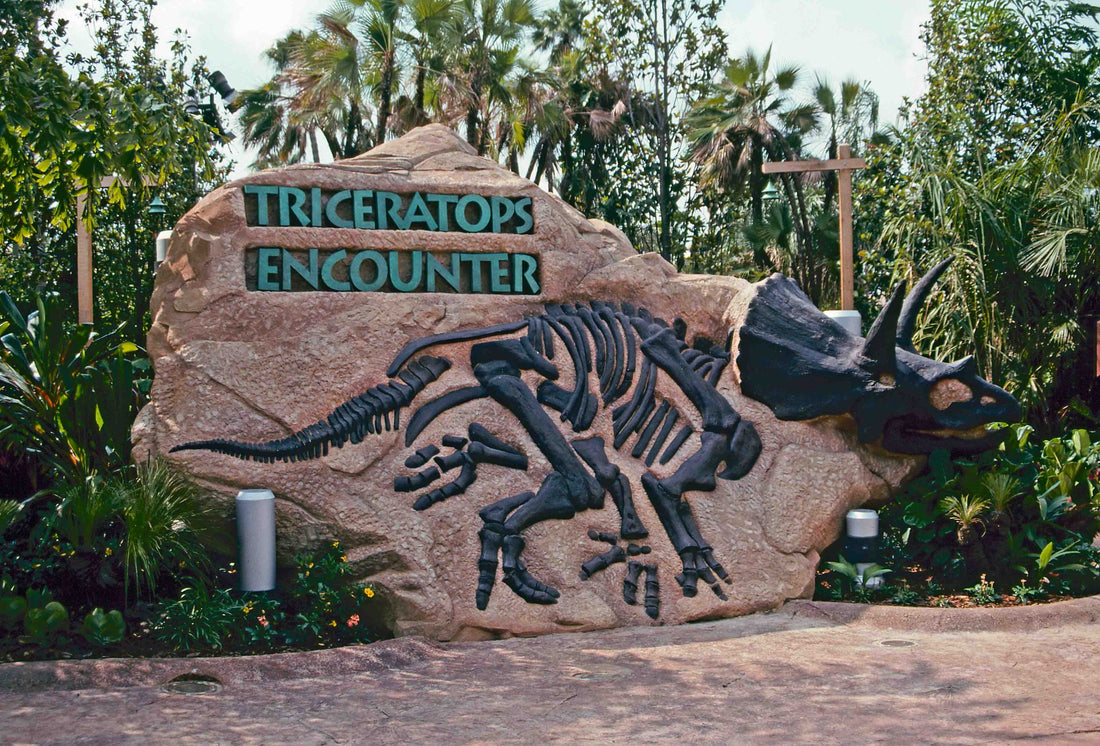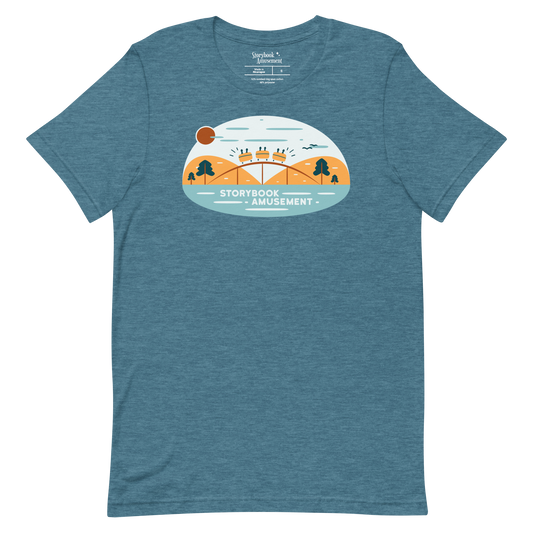Jurassic Park Comes to Life
Combine Steven Spielberg’s mastery, a regal John Williams score, as well as the beauty and terror of bringing extinct creatures back to life—it’s no wonder why Jurassic Park became an instant classic once audiences saw it in 1993. Confident they had a definite blockbuster on their hands, Universal Studios designed and began constructing Jurassic Park: The Ride for its Hollywood park while the film was still in production. The attraction opened in 1996, about three years after the film came out. Jurassic Park: The Ride put guests in the middle of a placid dinosaur exhibit that, inevitably, goes wrong. The experience offered moments as intense and as impressive as the hit movie.
Meanwhile, the creative team at Universal Studios Florida in the mid-‘90s was considering ways to bring the undoubtedly successful Jurassic Park ride to Orlando. With a massive franchise like Jurassic Park, Universal Creative expanded their plans of a standalone ride in Universal Studios to planning an entire land in the resort’s upcoming theme park at the time: Islands of Adventure. The unbuilt theme park was a blank slate for endless possibilities headed with creative direction that would bring the world’s most popular stories to life.
Watch on YouTube
This article is available in video form with accompanying visuals. Click HERE to watch it.
Creating a Jurassic Island
Universal when developing a new theme park had the undertaking to re-create the Mesozoic Period. The project would be led by show producer Bob Shreve, whose team workshopped a thought-out backstory for the land. Essentially, Jurassic Park’s founder from the movies, John Hammond, after the failure of his first park, built an improved version of a dinosaur attraction on Isla Aventura, an island south of the former Isla Nublar site. Universal’s Creative team storyboarded the land as if John Hammond got a second shot at building Jurassic Park where guests could visit a functioning version of the destination—in a few years, the public would have the opportunity to see the memorable gates in person and enjoy a host of dino-centered attractions.
The land’s plans were centered around the River Adventure ride. Jurassic Park’s supporting attractions would include a junior suspended coaster called Pteranodon Flyers; a play area named Camp Jurassic; a hands-on educational exhibit called the Discovery Center, which would be the icon of Jurassic Park as seen from many vantage points around Islands of Adventure; and lastly, a walkthrough attraction named Dinosaur Encounter. This attraction wouldn’t be a ride, but rather an interactive experience including state-of-the-art triceratops animatronics.
Encountering a Dino
The attraction’s early plans show a pair of identical triceratops paddocks that guests are able to enter and meet one of two triceratopses. The concept art had guests entering holding areas where they would watch a video pre-show before seeing the dinosaur. As for the encounter areas, guests would stand in a semi-circle around the triceratops’ head, and the dino was on a lowered platform for kids to have an up-close experience. With diagnostic equipment to the side and a dinosaur lifting mechanism above, the facility seemed to be set up for examinations.
The attractions’ plans expanded to have three barns instead of the original two. The new design would have guests stand in an L-shape to watch the triceratops, all on the same level as the dinosaur.
Reengineering a Prehistoric Creature
The three animatronics were engineered, modeled, and programmed by MD Robotics, Universal Creative, and Hall Train Studios. Being 24 feet long and 10 feet tall, the triceratopses were a lifelike size and were carefully designed to be as realistic and engaging as possible. To accomplish this, engineers visited a petting zoo in Toronto to observe how children interacted with live animals in a similar setting. This helped the creative team understand what kids typically expect and how they act when encountering a live creature. They noticed that zoo visitors touched and watched the animals’ heads more than any other areas of the body, leading the team to focus on detailed head sub-mechanisms when building the triceratopses, such as their tongues, nostrils, and eyes.
Since no theme park guest had actually seen a living dinosaur, Universal and the manufacturers could take some liberties in the design, but still had to take certain considerations into account. To make the dinosaurs as realistic as possible, they were created to have quiet, fluid, and nonrepetitive movements to give the sensation the creature would be alive and alert. Unlike the River Adventure ride, the animatronics wouldn’t be viewed from a distance in a boat—rather, guests would have the opportunity to get up close and touch them. That meant every detail had to be perfect. Making the triceratopses was challenging because they had to be more convincing than the movie and ride versions while interacting with guests, responding to touch, and being resistant to outdoor elements and Florida’s humid climate.
To pull off a convincing dinosaur pretense, the animatronics were outfitted with hand-painted skin made from a variety of silicones and also had a specially-made speaker installed in their mouths along with a hidden nearby subwoofer for booming growls. The animatronics weighed 7.5 tons and were produced to have 28 axes of motion and 34 articulated joints, making for a natural-seeming finished product.
Of course, if you asked Universal—these weren’t animatronics; they were living, breathing dinosaurs.
“The only way to create one of those is with DNA.”
Mark Woodbury, creative director of Islands of Adventure
The attraction, now under the name Triceratops Encounter, was set to welcome guests. It officially opened to the public alongside Universal’s Islands of Adventure on May 28, 1999. It was the world’s first chance in 65 million years to pet a moving, breathing dinosaur. The attraction was even a theme in advertisements for Universal’s new park, with a TV commercial showing a triceratops galloping to catch a frisbee.
The Triceratops Encounter Experience
Entering Jurassic Park
Past the fanciful lighthouse, through the streets of Marvel Super Hero Island, after the alleys of Toon Lagoon—guests would find themselves in the venturesome environment of Jurassic Park. Along the pathway, guests came across a large fossilized triceratops skeleton, marking the attraction’s entrance. Once entered, this led guests through the queue for Triceratops Encounter.
The Queue
The queue’s winding paths, although outdoors, were highly themed and took guests by a Jurassic Park Jeep sitting alongside an electric fence. Deep in the thick of Jurassic Park, the trail was surrounded by tropical plants and was expanded with the sounds of exotic birds, imposing jungle ambiance, and radio chatter over loudspeakers. Guests easily got the sense they stepped into a fictional world. The queue passed through pavilions that had a lived-in feel as if guests were about to visit a functioning triceratops stable.
The first pavilion in the queue was themed to a security station for game wardens. It had multiple surveillance monitors and gear showing what seemed like real-time activity around Jurassic Park and its habitats. The walls were lined with cases full of weaponry and equipment, including screen-used night vision goggles as seen during the T-rex encounter from the first movie.
After a forested trail, the queue would then enter a food compound area that had feeding stations and other equipment to care for the triceratops. Guest continued on the path, entering a fenced area until ending up in the final pavilion: a research outpost. With dinosaur crates, weighing stations, and workspaces, this site had a live spieling team member, which essentially served as the attraction’s preshow. With a utility truck off to the side, equipment nearby, and clutter everywhere, this area of the queue made it seem as if guests were stepping in on just another day at Jurassic Park.
From here, visitors were ushered into one of three triceratops paddocks where they would meet either Topper, who was the oldest; Chris; or Cera, whose name may be a reference to the triceratops character from The Land Before Time—a movie produced by Steven Spielberg: director of Jurassic Park and a creative consultant for Islands of Adventure.
The Attraction
Once inside the barn, guests would hear deep groans and grunts from a life-size triceratops within feet of where they were standing. Only a waist-high fence divided the crowd from the sedated triceratops, ready for a routine veterinary medical exam. The handler would share facts about the creature’s physiology, origins, behavior, diet, horns, and other information. Guests had the opportunity to ask the handler questions and were given the chance to pet the triceratops’ snout if they were tall enough to reach over the fence.
The triceratops throughout the demonstration maintained lifelike movements and emotional deployments such as breathing, flaring her nostrils, sneezing, blinking, urinating, and lifting her leg in a defensive stance. The dinosaur even had an odor to give the sense a real triceratops was within arm’s reach. Under anesthetics, the dinosaur stayed in one spot. At one point during the checkup, she would have a tantrum and be more active, but the handler would calm the triceratops down by distracting her with leaves and branches. The up-close-and-personal experience lasted about 10 minutes before sending guests on their way to enjoy the rest of Jurassic Park and Islands of Adventure.
Reception and First Hiatus
What Universal was able to pull off with Triceratops Encounter was an accomplishment in bringing a truly one-of-a-kind theme park attraction to its lineup. Despite being visually and technologically impressive, it was a low-stakes experience with a slow-moving dinosaur that stayed in place, unlike the sharp-toothed dinos on River Adventure and the white-knuckle rides around the park. Triceratops Encounter was not among Islands of Adventure’s must-do attractions when it opened in 1999. It drew lower-than-expected crowds—certainly when compared to the park’s headlining, thrill-centric attractions.
Islands of Adventure during its first few years of operation experienced disappointing parkwide attendance, causing the resort to evaluate its offerings. Due to underwhelming guest turnout and feedback, Universal made the decision to inactivate Triceratops Encounter in fall 2001 until further notice. The attraction at this point had been operating for about only two years. When asked whether it would reopen during the holiday season, a park spokesperson stated Universal would make adjustments based on guest demand. Triceratops Encounter would stand dormant until further notice.
Luckily for Chris, Topper, and Cera, the attraction would later reopen in 2002, now taking the name Triceratops Discovery Trail. Its new title gave guests a better sense of what they could expect—a leisurely, slow-paced walkthrough attraction.
Horror Haunts the Trail
That same year, 2002, the Triceratops Discovery Trail venue was used for Universal’s annual fall haunt event, Halloween Horror Nights—its first year being hosted in Islands of Adventure. Triceratops Discovery Trail housed a maze called Project Evilution in that a sinister scientist unveiled their latest experiment: human-dinosaur hybrids. The house went through a triceratops paddock where one of the animatronics was used as a prop. She was surrounded by a destroyed enclosure and strobing lights to give a more threatening appearance.
As the maze furthered into the Jurassic Park jungle, the end of the house displayed a gruesomely separated triceratops head, which was actually a screen-used prop from The Lost World: Jurassic Park. Once Halloween Horror nights came to a close at the end of the season, Triceratops Discovery Trail returned to standard operations in Islands of Adventure’s lineup.
The Experience Faces Endangerment
As time went on, the attraction turned out to be challenging to maintain, leading to frequent downtime. When one of the three triceratopses went down due t technical delays, that cut the attraction’s capacity by a third. In some cases, the technical difficulties happened in front of guests, breaking the illusion that it was a real dinosaur. Universal of course would want to minimize these instances as much as possible.
Triceratops Discovery Trail closed for extended seasonal maintenance in 2003 after the venue was used for another haunted maze during that year’s Halloween Horror Nights event. It reopened as scheduled in December of that year, but the attraction was standing on its last leg. On April 14, 2004, Triceratops Discovery Trail gave its final show to the public. Universal explained the dinosaurs grew up and would be released with their herd—or battery as it’s referred to.
The short-lived attraction would leave behind a legacy of having advanced, larger-than-life animatronics that brought dinosaurs back from extinction, but the technology, being as complicated as it was, was unreliable. Overall, Triceratops Encounter could be described as gentle or interesting at best. There was no climax, no suspense, and not much of a story to captivate guests. Take a look at an attraction like Alien Encounter at Magic Kingdom—it made guests face their fears, catching the audience by surprise. Triceratops Encounter didn’t have those types of moments. Within five years of on-and-off operations, Triceratops Encounter went extinct.
Rediscovering the Trail
Heading into the 2010s, Universal Orlando Resort was one magical expansion away from being a true competitor with Disney. Islands of Adventure’s attendance numbers skyrocketed in 2010 after The Wizarding World of Harry Potter: Hogsmeade opened. As the park headed into one of the busier times of the year, the holiday season, Universal reopened Triceratops Discovery Trail on December 13, 2010, under seasonal operations to accommodate heavy crowds as needed. After sitting dormant for over half a decade, the attraction was nearly identical to how was years prior. The most notable changes were that the queue was now bypassed with guests entering through the former exit, and, during the medical exam demonstration, a handler would bring in a baby triceratops to see its mother. The baby was a small puppet held in the arms of the handler at all times. Guests were able to pet and interact with the baby.
Triceratops Discovery Trail reopened seasonally for only short bursts at a time from late 2010 until its final day of operation on January 1, 2012. Without fanfare, only about a year after reopening, the attraction officially closed permanently.
On occasion, the trail and its backstage areas were utilized as overflow queue space for the nearby Harry Potter and the Forbidden Journey attraction. After the early 2010s, however, the venue would go completely unused, standing abandoned in the middle of one of the world’s busiest theme parks. Urban explorers during this time trespassed and explored the attraction in its disused state; as storm debris covered the unmaintained pathways, the animatronics and queue props were all left behind with a hopeless future.
Raptors Discover the Trail
By 2015, the Jurassic franchise was back in the public eye with Jurassic World dominating the box office that summer. Islands of Adventure seemed to be making way for a new generation of Jurassic attractions. Observant parkgoers around the same time noticed activity on the Triceratops Encounter site for the first time in years. Construction crews were prepping the abandoned location for an all-new Jurassic World experience.
Triceratops Encounter’s successor opened May 22, 2015: a new meet-and-greet called Raptor Encounter where guests can get up close and personal with a live dinosaur, only this time, there was suspense, there was uncertainty, there was real excitement worth doing every trip to the park. Raptor Encounter took up a small portion of the former Triceratops Discovery Trail site. Most of the existing pathways and buildings were left untouched. A few of the former Triceratops Encounter buildings were used for team member break areas; general storage; and staging for the raptor puppets, which were created by renowned puppet designer Michael Curry.
With Raptor Encounter being an instant hit, the Triceratops Discovery Trail attraction was gone but not forgotten. In the mid-2010s, guests once again got the opportunity to meet a triceratops as a walkaround handler in the Discovery Center held a baby triceratops who loved being pet.
A few years later, Universal Studios Hollywood and Japan both debuted a walkaround triceratops meet and greet experience.
Extinction Hits the Trail
In 2018, rumors circulated that Universal was preparing to repurpose the defunct Triceratops Encounter plot of land. The park began prep work on the old site and started clearing out and excavating what was left behind from the old attraction. That summer, disused Triceratops Encounter props made their way into the Williams of Hollywood Prop Shop in Universal Studios Florida, which is a store that sells actual props and items used in the park. This included light fixtures, a dino crate, a bag of dino chow, and various equipment. By 2019, construction was moving forward where Triceratops Encounter used to stand as crews began demolishing the former pavilions and paddocks. Raptor Encounter would eventually move to another location in Jurassic Park, clearing the space for a cutting-edge attraction.
The final remnant of Triceratops Encounter seen in the park was its retired sign, which for years stood as decoration with general triceratops info printed on it rather than the attraction’s name. The slab was removed as a part of the ongoing construction. Triceratops Encounter had been completely wiped from Islands of Adventure’s history, for now.
Raptors Reclaim the Land
A new apex predator of coasters launched June 10, 2021, in Jurassic Park at Islands of Adventure. The Jurassic World VelociCoaster is perched in the back of the park on the same spot an extinct, opening-day attraction once inhabited. Since opening, Jurassic World VelociCoaster has blown riders away with its speeds, inversions, and overwhelming intensity. Beyond what the track does, the coaster’s next-level storytelling takes riders through Jurassic World’s raptor paddock, right by the clever dinos. And it’s here that Triceratops Encounter lives on. After the dive loop in the first portion of the ride, the coaster speeds by a bag of dino chow tucked away under the track. This bag is a reference to the props previously seen in Triceratops Encounter.
This week's new hand-drawn layouts! 🎨 Both TRICERATOPS ENCOUNTER and VELOCICOASTER bring you face-to-face with Jurassic Park dinosaurs... In the latter, they're just faster & meaner.
— Park Lore✨ (@ThemeParkLore) April 25, 2023
See more before-and-after layouts overlaid with comparison sliders at https://t.co/qcbRhFvmfs! pic.twitter.com/b81q6GBiXW
In summer 2021, Universal Studios Florida opened a temporary Jurassic World tribute store in conjunction with Islands of Adventure’s new coaster. Among the many Jurassic sights, merch, and treats to appreciate, the popup shop had a caged triceratops photo op. Though not exactly like Triceratops Encounter, this is the closest guests could get to a three-horned dinosaur since the attraction closed permanently about a decade prior. The prop used is thought to be the same one as the decapitated triceratops as seen in the 2002 Halloween Horror Nights house from the Triceratops Encounter venue. True to the triceratops theme, the store sold dino chow snacks as a nod to the lost attraction.
The plot of land has evolved over the years—what’s now a raptor paddock was once a trio of barns with life-like triceratopses. An experience 85 million years in the making—extinct after an on-and-off decade. This fossil of the past is a significant part of the park’s history and how it continues to innovate and impress with each new addition.





